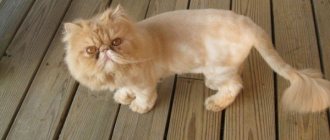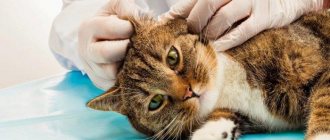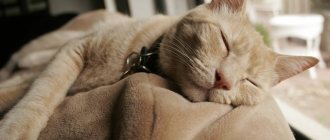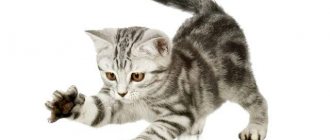Home » Useful Information
Grooming cats is often not a whim of their owners. In most cases, cat grooming is about caring for the health of the animal. But sometimes kitty owners want to improve their appearance in this way. Why not?
If you want to look at crazy cat haircuts, we recommend checking out this article
A haircut is necessary if the matted fur tightens the cat's skin, causing it pain and discomfort. As a result, the cat may become nervous and not allow itself to be petted.
- 2 How often should you get a haircut?
- 3 What do you need to know before grooming a cat?
- 4 Types of cat haircuts
4.1 Hygienic haircut
- 4.2 Model haircuts
Why do you need to cut your cat's hair?
The main reason why a cat needs a haircut is mats.
They can cause serious harm to the animal's health.
- Firstly, the matted fur tightens the kitty's skin, causing it pain and discomfort. As a result, the cat may become nervous and not allow itself to be petted.
- Secondly, in places where tangles form, blood flow and heat exchange are disrupted. Naturally, such conditions are ideal for the proliferation of all kinds of pathogenic bacteria and fungi. The animal's skin may become very inflamed, itchy and flaky.
This article will tell you what to do if your cat’s hair falls out and bald spots form.
During daily licking, cats eat a lot of their fur, which can harm their digestion. To avoid problems, regular grooming of cats is necessary.
- Thirdly, a kitty may try so hard to get rid of tangles on her own that she will injure herself. A side effect of such diligence can also be eating a large amount of wool, which becomes a lump in the stomach, causing vomiting or, even worse, clogging the passages in the digestive tract. In the latter case, you cannot do without the help of a veterinarian. A cat also eats a lot of fur when shedding. During these periods, it is also recommended to groom your beauty and comb her with a furminator .
- Fourthly, due to age, the cat may not be able to take good care of its fur. In this case, tangles can appear literally every week, and the old kitty’s coat will look untidy.
Another reason why cats are cut is due to various skin diseases of the animal. In some cases, a cat's haircut is necessary because its owner is allergic to fur.
We also recommend that you familiarize yourself with the list of hypoallergenic cat breeds in the article
- A haircut? No, I haven't heard
Is it necessary to trim during shedding?
Long-haired and even short-haired animals are also cut during molting, because... this helps to get rid of some of the hair, because when it is short, dead hairs fall out more easily, and besides, they are not so long, and therefore do not fly around the house. However, there are other more effective ways to deal with shedding: shaving and trimming are not a priority.
You cannot cut cats of shaded and point colors, because... The new coat will grow darker. And remember: some cats, after a haircut, do not grow hair to the previous length or grow it very slowly. In addition, the coat may become thinner after cutting.
How often should you get a haircut?
The frequency of grooming cats, photos of which can be offered at a pet salon, depends on the structure and length of the animal’s fur.
Long-haired kitties like Persians , Siberian cats , as well as Ragdolls and Maine Coons , require grooming more often than their counterparts with medium-length fur. Although the latter will be happy to shed their fur coat during the summer season. That's why haircuts for British cats ; photos of these little leopards with different hairstyles are simply touching.
The frequency of haircuts is determined by the rate at which the hair grows and how it becomes tangled. On average, a kitty has time to grow in about 3-6 months, therefore, grooming can be carried out three times a year.
- Cut my hair, cut my hair!
If you want to cut your cat's hair less often, you need to brush it more often. The areas where mats most often form are the armpits, the area between the hind legs, behind the ears, on the neck and tail.
Some people believe that grooming is not necessary, just cutting off the tangles in time is enough. Yes, you can do this, but then the aesthetics of the animal’s appearance will leave much to be desired. It is also dangerous because tangles form in areas where the skin is very delicate, and cutting them off can injure the animal. After all, sometimes it is quite difficult to distinguish where the skin fold ends and the tangle begins.
Owners should remember that after a haircut, the structure and color of the coat may change.
Tools for grooming furry cats
Most often, sharp, well-sharpened, medium-sized scissors are used for this hygienic procedure at home. Is it possible to cut a cat's hair with a regular clipper? A clipper is the most convenient in this procedure, because with it it is almost impossible to injure the animal. Its only drawback is the noise during operation, which can frighten the cat. That is why it is recommended to choose the most silent models.
In addition, you will need the following tools and accessories:
- A comfortable comb (preferably with soft teeth that will not cause unnecessary distress to your pet).
- Hydrogen peroxide (if you accidentally hurt your cat).
- Scissors (if you still decide to use this tool, it is advisable that the scissors have rounded ends).
- Comfortable horizontal surface (for example, a desk).
- An unnecessary towel that should be placed on your desk (after which you simply collect it and throw it away).
- The cat’s favorite toy (with its help you will distract the animal from a not very pleasant process).
What do you need to know before grooming your cat?
- Before the exhibition, the cat is cut no later than six months in advance. It is impossible to cut your hair bald with such plans.
- Restless cats are given muscle relaxants.
- After trimming, the structure and color of the coat may change, but this is rare.
- Some kitties cannot restore their coat for a long time.
- It is strictly forbidden to touch the hair on the head, face and ears.
Hygienic grooming of cats is indicated mainly for long-haired breeds - Persians, Norwegians, Siberians, Angoras and so on. Often the procedure is carried out if the fur is very tangled, tangles have appeared that can no longer be combed
LiveInternetLiveInternet
Our favorite shorthairs!
Their amazing plush coat with a soft shine and always neat and elegant appearance create a deceptive impression that this breed does not need any complex coat care and does not require a special diet. Actually this is not true. The famous plush coat has a complex two-level structure: a dense “stuffed” undercoat and guard hairs slightly protruding above it. It is this structure of the coat that creates the pearlescent shine on blue and lilac colors, and gives shine to black and chocolate. This fur coat requires special care.
British Shorthairs, like Scottish ones, are massive and heavy cats. To maintain massiveness, animals need a special diet with a high protein content (33-34%). Before the exhibition, even adult male cats can be put on food for kittens and pregnant cats for 2-3 weeks, which contains even more protein, but in this case vitamin supplements must be excluded from the diet to avoid allergies.
British and Scottish people need vitamins high in biotin, calcium and trace elements in their daily diet. Vitamins from the company “8 in 1” or “Gimpet” give very good results. They contain all the necessary substances and are readily eaten by cats. If you want to emphasize the red color in an animal’s color, give vitamins with seaweed. Tortoiseshell, red, chocolate colors will become brighter, and lilac will acquire a warm pink tone. But it is better not to give seaweed supplements to blue, cream chinchillas and blue-cream cats: the color will darken.
But all cats need calcium, especially kittens and nursing mothers. The plush coat of the British Shorthair is insidious. When licked, the fur enters the stomach and settles there in the form of insoluble lumps. This can lead to blockage of the intestinal passages. Fortunately, such a disaster is easy to deal with. about 7-8 months, animals need to be accustomed to a special paste. It helps dissolve fur in the stomach and is pleasant to the taste.
From childhood, a kitten should not be accustomed to everyday grooming, then in the future he will understand that examination of ears, eyes, teeth, and coat care is part of his life and will not resist examination at the veterinarian and judge’s table. Once every two weeks we examine the cat’s ears: the shells should be clean, without rashes, plaque, or unpleasant odor. Using a cotton swab, carefully clean the ear canal. In a healthy animal, sulfur is light and odorless. Often longer hairs called “tassels” grow at the end of the ear. They need to be removed. To do this, hold the tip of the ear with the fingers of one hand, and at the same time cut the hairs or pluck them with the other.
The eyes of British and Scottish cats, as a rule, do not require special care. In the morning, sometimes dark plaque accumulates in the corners of the eyes, which is removed with a solution of boric acid or simply with water applied to a soft cloth or paper napkins. Purulent discharge is unacceptable. If they appear in an animal, then consultation with a veterinarian is necessary.
Claws also require constant attention. They must be strong and not flake, and peeling at the base of the claw can be the beginning of a fungal disease. Inspection and trimming of claws is carried out every 2-3 weeks . The claws on the front paws grow faster than those on the hind paws. Before cutting, look at the claw in the light: it contains a blood vessel that should not be touched. By regularly trimming your nails, you will save yourself, your furniture, veterinarians and judges from too much stress. From the first day your kitten is in your home, think about a scratching post - this is one of the necessary items for a kitten to play with.
Now let's talk about the animal's fur. It requires care and attention. Britons are the only short-haired breed that loves brushing and stroking against hair growth.
To care for the coat, you need the following tools: a metal, medium-frequency comb, preferably Teflon-coated, with rounded teeth that do not scratch the skin; massage brush, preferably a combination brush - on one side there are natural bristles, on the other - metal teeth with an antistatic coating.
Grooming is easy. 1-2 times a week, using a metal brush and a massage brush, we comb the coat, first in the direction of hair growth, and then against it. This is a wonderful massage. Comb the fur first on the back, along the sides, and on the chest. The cheeks and neck are massaged towards the muzzle, i.e. e. against the grain. Cats love this procedure, they purr loudly and prop up their backs. After combing, excess fur is removed with wet hands or a special rubber mitten. A post-shedding spray or protein conditioner will improve the structure and maintain the shine of the coat. If an animal has dandruff, scratching is a cause for concern, and perhaps for contacting a veterinarian. Once every 2-3 weeks you need to clean the fur coat using dry shampoo or grooming powder. The powder contains cleansing agents and silicone. The powder is applied to the fur, rubbed in with your hands, and then thoroughly combed out with a brush. This procedure will clean the wool of dust and grease, remove static electricity and add volume. Baby powders, even the most expensive ones, are not suitable, since they are based on rice starch, which, after licking, enters the stomach and can cause upset.
Brush the cat with a comb, first along the fur, then against it. This will remove dead hair - guard hairs and fluff. Pay attention to your back. As a rule, along the ridge, especially closer to the tail, there is more guard hair. It needs to be trimmed. To do this, hold the hair with the fingers of your left hand, and remove it with the fingers of your right hand. All procedures must be performed calmly so that the cat does not perceive them as punishment. It is better to remove guard hairs during estrus or molting, but no later than 3-4 weeks before the exhibition. On dark colors it is necessary to remove any white hairs.
After trimming, you need to allow your hair to recover. It is good to use a conditioner - a spray for removing hair after shedding and a conditioner - a spray with protein. These sprays will help in preparing the cat for the exhibition: they treat the animal’s fur daily for three weeks in a row. The conditioner is sprayed from a distance of 15-20 cm , lightly rubbed into the wool and allowed to dry.
All cats are washed, regardless of whether they participate in exhibitions or not, at least once every three months. For everyday washing, use high-quality shampoos for cats based on seaweed, medicinal herbs, lecithin, conditioner, and antistatic effect. Then your cat will always be well-groomed, with beautiful shiny fur, and you will always be ready for a show.
5-6 days before the exhibition : if you want to improve the color, you can use tinted shampoos for cats, but for the first time it is better to wash the animal long before the exhibition in order to learn how to use them.
Features of washing cats of different colors.
White cats are washed with white cat shampoo 2-3 times. After secondary soaping, leave the shampoo for 2-3 minutes and then rinse off.
Chinchilla and silver marbled cats are also washed with shampoo for white animals, but when soaping again, do not keep it on the fur, but rinse it off immediately.
Blue, cream, lilac, blue-cream and lilac-cream colors are sometimes darkish. Then you can use shampoo for white cats. It will give the coat a lighter color.
Red, red-marbled and tortoiseshell cats are washed with red or bronze shampoo.
Chocolate cats are washed with bronze shampoo, adding a few drops of shampoo for black animals.
Black cats are washed with black shampoo.
It is better to use shampoos from well-known companies. There is no point in experimenting before an exhibition. Choose the right shampoo in advance.
The washing process is the same for all cats. Water temperature 38-40 °C. Holding the cat by the shoulders or under the chest with one hand, wet the fur and apply shampoo to the withers, back, chest, belly and tail. Create a rich lather and rinse the coat thoroughly. Pay attention to the tail: in adult cats, sometimes it needs to be washed additionally. After the second soaping and rinsing, you can use a special fluffer. It is applied to the animal's fur and then washed off with water. After this, the cat needs to be wrapped in a towel and transferred to the table. Dry it, changing the towel 2-3 times. Then apply a little dry shampoo or grooming powder to the damp coat and massage; When all the powder has been removed, spray the wool a little with Coat Gloss spray and dry it with a hairdryer. When drying, lift the coat with a metal massage brush. You need to dry it completely, then the wool will be voluminous longer.
At the exhibition, you need to lightly powder the back and cheeks of the animal, lift the fur with a brush with natural bristles, let it dry, and then lightly moisten it with an antistatic agent. After this, trim the fur on the back with your hands.
Remember that grooming is an art and needs to be mastered at home . Both you and your pet must learn to endure all procedures patiently and calmly. Even if your pet doesn’t immediately like everything you do to him and he uses his claws and teeth, you shouldn’t punish him for this. On the contrary, caress him, calm him down, treat him with a treat, distract him with a toy.
And remember: all your efforts will return to you in the form of awards and cups.
Good luck to you and your pets!
Based on an article from the magazine “Friend” 6-7, 1998
Types of cat haircuts
Hygienic haircut
This type of grooming is also called home grooming and is indicated mainly for long-haired breeds of cats: Neva masquerade cats , Norwegians , Somalis , Angoras and so on. Often, the procedure is carried out if the fur is very tangled, tangles have appeared that can no longer be combed.
A hygienic haircut is also needed if there are skin diseases from which no one is immune. Therefore, it may be necessary, for example, to groom Scottish cats. Photos and videos posted on the Internet show how this can be done best.
A hygienic haircut is usually performed with a professional clipper with attachment No. 3 (3 mm long wool remains). This length of fur does not prick and does not cause itching. The animal's skin becomes plush, velor-like to the touch. Sometimes, in particularly difficult cases of animal skin disease, there is a need to trim the cat using attachments No. 1 and 2.
Grooming cats is a complex process that requires the owner not only a steady hand, but also patience
When hygienic cutting, hair is left only on the head, paws (to the middle) and at the tip of the tail.
Important! Under no circumstances should the hair be completely removed from the tail. Cats react strangely to their hairless tails and chew them, leaving deep wounds. The shortest uncut length is 1/3 of the tip of the tail.
Model haircuts
Often, the organization of such a haircut is justified by the desire to emphasize the character of the animal or make it more attractive.
Model haircuts are performed with a nozzle on the machine No. 3; thinning and hairdressing scissors and various combs are also used.
The most common type of cat haircut is that of a lion.
Many model haircuts can be performed on the basis of a hygienic one, which will allow you to achieve two goals at once - remove tangles in certain places and create a new image of the cat.
This is exactly what cutting a cat like a lion is like, when the hair is completely cut off from the entire body, leaving it only on the head and the tip of the tail.
Interesting! Just like in the situation with cats, dogs also undergo grooming . Haircuts are done both with scissors and with a special clipper .
The “Puma” haircut is similar to the “Lion” haircut with the difference that the hair is left not only on the head, but also on a small part of the body.
It looks like the kitty is wearing a short furry vest.
Real Puss in Boots
The Dragon cut means that the hair remains on the head, paws, tail and spine.
Now the fur remaining along the back and on the tail is cut into triangles and made into mohawks.
Extravagant dragon haircut
Model haircuts may contain various decorative elements on the back or sides: drawings, letters, geometric figures.
How to trim a cat's hair at home: instructions
Below is the sequence of actions that you need to follow:
- First of all, shorten your cat's claws using special pliers. Tools should be disinfected first. Afterwards, lightly press on the pet’s paw pad and carefully and at the same time quickly remove the claws without touching the skin. Thanks to this, you will be able to protect yourself from pet aggression and scratches during a haircut.
- If the haircut is being done for the first time, it is advisable to use the help of a second person who will gently hold the cat from the sides. Some animals will behave quite aggressively. For such individuals, veterinary clinics sell special plastic collars that allow you to fix the cat's head in one position and prevent it from biting. As for the limbs, you still have to hold them.
- After the animal is laid on its side and its paws are securely fixed, the machine can be used. Start removing hair from the sides, being careful and leisurely. If the cat feels the owners' anxiety, it will also experience stress and begin to break out and scratch.
- After the sides you need to move on to the back and stomach. Particular attention is paid to cats with mammary glands: if you use scissors, it is important not to injure this sensitive area, so try to relax the animal as much as possible. You can move both with the growth of the fur and against it.
- It is recommended to remove the remaining hairs with small scissors, since sliding the machine over the animal’s skin is not worth it: this causes discomfort and microtrauma.
- During the procedure, lightly pull the animal's skin, especially if the cutting is done with scissors. This will prevent cuts.
- At home, the tail and paws are usually left untouched, but if you wish, you can shave the hair off the tail with a clipper, leaving a small brush at the end (this is an excellent option for show breeds).
- At the end of the procedure, the cat should be washed in warm water; if desired, a small amount of mild animal shampoo should be added to the water. Next, the pet is dried with a hairdryer, which is set to the most silent setting.
What should you use to cut your hair with - a machine or scissors? If you want your pet to look really attractive and neat, it is recommended to alternate the use of scissors and clippers. With scissors, you simply trim what the automatic device could not remove. Grooming long-haired animals exclusively with scissors will be long, dangerous, and the result may not be neat enough.
Is it possible to cut wet wool? If you use a machine, it can be used on dry animal skin. Decided to make do with scissors? In this case, it is recommended to slightly wet the fur and comb it thoroughly: this way it will be easier for you to remove unnecessary hair. Regardless of the breed, you should not cut the animal too short (it is better to leave a couple of millimeters of fur). Thanks to this, you will ensure normal thermoregulation and, in addition, avoid injury to the skin.
Information about Persian cats
Cats of this breed are quite impressionable, so before starting the procedure, it is better to first find a video on the Internet on how to trim a Persian cat at home.
For Persian cats, a haircut similar to that of a lion is used.
To groom cats of this breed, it is better to involve assistants who will help calm the animal. For Persian cats, they use a haircut similar to that of a lion - the head, tail and paws are left unchanged, this is a classic hairstyle for representatives of this breed.
Features of summer haircuts
Most often, owners have a desire to cut their cat's hair in the summer, when the pet is languishing from the heat. Even in this case, cutting is not advisable. It is better to provide the animal with free access to water and a cool place to rest, for example, a tiled floor in the bathroom or an area under the air conditioner.
It is strictly forbidden to cut pets very short or bald. When using small attachments (1 mm or less), there is a high probability of injury to the skin. In addition, an animal completely devoid of hair suffers even more from overheating and can even get burns.
Nature itself took care of protecting the cat by providing a special air cushion between the cover and the skin. Usually the animal easily adapts to any weather conditions.
Cats walking outside have a particularly hard time with short summer haircuts. In addition to overheating and burns, they are at risk of various skin diseases, practically devoid of natural cover.
For cats that do not leave the apartment and lead a sedentary lifestyle, if they have very long and thick hair, like Persians, summer hair shortening is quite possible.
All owners of British and Scottish Fold cats with thick, plush fur are simply divided into two categories. These are those who regularly groom their pets in the summer, and those for whom this procedure is unacceptable under any circumstances.
Prices for haircuts for cats in grooming salons in Ukraine and Russia
Russia (current prices in Moscow and St. Petersburg)
- Hygienic haircut – 1000-1500 rubles;
- Model haircut – from 1500 to 2500 rubles;
- Cutting patterns - the price is negotiated individually;
- Grooming at home - included in the cost of a haircut or plus 500 rubles;
- Additional payment for the aggressiveness of the animal - 500-1200 rubles.
- Haircut using anesthesia - from 1900 rubles.
Ukraine (how much does grooming cost in Kyiv)
- Hygienic cat grooming – from 200 hryvnia;
- Model haircut – from 300 hryvnia;
- Fantasy haircut, cutting of patterns - the price is negotiated separately depending on the complexity of the pattern;
- Grooming at home – 300 hryvnia;
- Haircut with anesthesia in the salon and at home – 350 hryvnia;
- Additional payment for cat aggressiveness is 50% of the cost of services.










